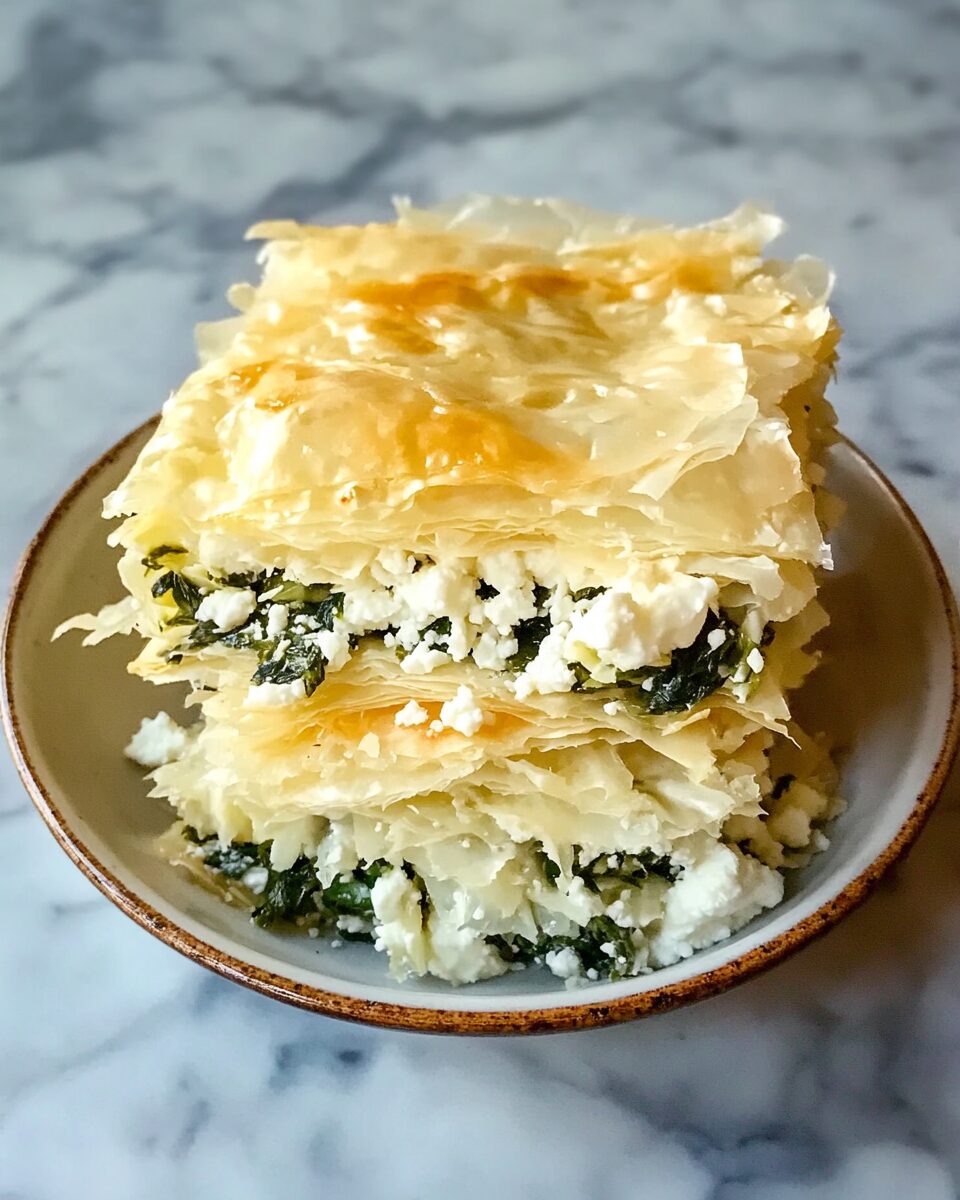This Greek Spinach and Feta Pie, known as Spanakopita, is a beloved classic of Greek cuisine and a shining example of the Mediterranean diet at its best. Featuring layers of flaky phyllo pastry brushed with olive oil and filled with a delicious blend of spinach, herbs, and feta cheese, this savory pie offers both comfort and nutrition in every bite. Passed down from generations, the authentic recipe balances earthy greens with the tanginess of feta and the fragrant freshness of dill, parsley, and mint. Spanakopita is incredibly versatile—it can be served as a main dish, side, appetizer, or even a light breakfast or lunch, hot or cold.
Full Recipe:
Ingredients
-
1 lb frozen spinach, thawed and squeezed dry
-
1 medium onion (or 3–4 spring onions), finely chopped
-
2 tablespoons olive oil (plus more for brushing phyllo)
-
3 tablespoons chopped parsley
-
2 tablespoons chopped dill
-
1/4 cup chopped fresh mint (or 2 tablespoons dried mint)
-
1/4 teaspoon nutmeg
-
1 teaspoon sugar
-
10–12 oz feta cheese, crumbled and grated
-
2–3 medium eggs (or 2 large)
-
12 sheets of phyllo dough
Directions
-
Preheat oven to 350°F (180°C).
-
In a skillet, heat 1 tablespoon of olive oil and sauté the onions until soft.
-
Add the squeezed spinach and cook for a few minutes until moisture evaporates. Stir in herbs, nutmeg, and sugar. Cook 2–3 minutes and set aside to cool.
-
Beat the eggs and mix with grated and crumbled feta. Combine with the spinach mixture and add remaining olive oil.
-
Brush a 10×15-inch baking pan with olive oil. Layer 6 sheets of phyllo, brushing each with olive oil.
-
Spread the spinach mixture evenly over the base. Top with 6 more phyllo sheets, again brushing each one with oil.
-
Trim or fold in excess phyllo and score the top layers into 10–12 squares.
-
Bake for 40 minutes or until golden brown. Let cool slightly before cutting and serving.
Nutrients (Estimated per piece, serves 10)
Calories: 252
Fat: 17g
Carbohydrates: 15g
Protein: 9g
A Timeless Greek Classic with Deep Roots
Spanakopita is deeply rooted in Greek culinary history, with variations found throughout the country. It reflects the agricultural abundance of the Mediterranean—particularly the use of seasonal greens, local cheeses, and fresh herbs. Traditionally, spanakopita was made in rural homes using wild greens and herbs gathered from the countryside. Feta cheese, a staple in Greek diets for centuries, added richness and tang to the filling, while olive oil served both as a flavor enhancer and a functional component for crisping the phyllo.
Today, spanakopita has become a symbol of Greek hospitality and comfort food. It’s found at every type of gathering, from casual family dinners to festive celebrations, and is often passed down in hand-written recipe cards through generations. Its enduring popularity comes from its harmonious balance of flavors, ease of preparation, and adaptability across occasions.
A Nutrient-Dense Dish That’s Light Yet Satisfying
Spanakopita fits beautifully into a health-conscious lifestyle, especially within the framework of the Mediterranean diet. It’s naturally packed with nutrients thanks to the abundance of leafy greens and herbs in the filling. Spinach, the primary green used in this dish, is rich in iron, fiber, folate, and vitamins A, C, and K. When sautéed and combined with onion and herbs, it becomes a deeply flavorful base that anchors the dish without the need for heavy sauces or additives.
Feta cheese provides a salty tang and creamy texture while contributing calcium and protein. Unlike many other cheeses, feta is lower in fat and calories, making it an excellent choice for those looking to enjoy dairy in moderation. Olive oil, used generously to brush the phyllo, offers heart-healthy monounsaturated fats and adds richness without overwhelming the lightness of the filling.
The result is a dish that feels indulgent yet nourishing. A single serving provides protein, fiber, and healthy fats—all in a compact, flavorful slice. Spanakopita is proof that eating well doesn’t have to mean sacrificing flavor or enjoyment.
Phyllo Pastry: Crisp, Delicate, and Surprisingly Easy
Phyllo dough, though delicate, is surprisingly forgiving once you get the hang of working with it. Its whisper-thin sheets bake up into a golden, shatteringly crisp crust that elevates the dish with both visual appeal and texture. Each sheet is brushed lightly with olive oil, not only to aid in browning but also to create distinct layers that puff and separate in the oven.
In traditional spanakopita, phyllo is used generously—layered at the bottom for a sturdy base and at the top for a crisp lid that locks in the moist filling. You can use 12 sheets, typically half on the bottom and half on top, ensuring even coverage and a balanced crust-to-filling ratio. The process of layering and brushing may seem time-consuming, but it’s a meditative task that brings a rewarding sense of craftsmanship.
Spanakopita can also be made in individual triangles or rolled into spirals for party-ready finger food. The slab-style version, baked in a rectangular pan and cut into squares, is the most traditional and easiest to serve at family meals.
Herbs and Seasoning: The Soul of the Filling
One of the most distinctive features of authentic spanakopita is its use of fresh herbs. Dill, parsley, and mint are the stars here, bringing brightness and complexity to the otherwise earthy and savory filling. Dill adds a slightly grassy, citrusy note that pairs beautifully with feta. Parsley contributes freshness and depth, while mint offers a surprising lift that enhances the overall aromatic profile.
Nutmeg, a traditional touch in many Greek pies, adds subtle warmth and ties the filling together without overpowering the herbs. A small pinch is all it takes to add that extra layer of flavor that makes homemade spanakopita taste like something truly special. A touch of sugar, though not always included, can help balance the saltiness of the cheese and the bitterness of the greens.
These thoughtfully chosen ingredients work in harmony, creating a layered, fragrant filling that bursts with flavor in every bite.
Versatile, Make-Ahead Friendly, and Crowd-Pleasing
One of the reasons spanakopita has endured through the ages is its incredible versatility. It can be served hot, warm, or cold, and it travels well—making it perfect for picnics, potlucks, or packed lunches. It also reheats beautifully, retaining much of its texture and flavor even after a night in the fridge.
Spanakopita can be enjoyed in numerous ways. It makes a great vegetarian main course when paired with a Greek salad or a bowl of lentil soup. It also works beautifully as a starter, cut into small squares and served as an appetizer at dinner parties. As a side dish, it complements grilled meats, seafood, or roasted vegetables. You can even serve it for breakfast or brunch alongside fruit or yogurt for a savory twist on the morning meal.
Because it can be prepared in advance, spanakopita is an excellent choice for entertaining. Assemble the pie earlier in the day, refrigerate it, and bake just before guests arrive. You can also freeze it unbaked and cook it directly from the freezer, extending its convenience even further.
A Dish That Invites Tradition and Personalization
While the classic spinach-feta filling is the most recognized version, spanakopita is endlessly adaptable. In Greece, regional variations abound. Some recipes incorporate leeks or chard instead of spinach, others use ricotta or anthotyro cheese in addition to or instead of feta. Some families add pine nuts or raisins for texture and sweetness, while others opt for garlic or scallions for a bolder flavor.
At its heart, spanakopita invites personalization without losing its identity. It’s a dish you can make your own while still honoring the traditions from which it came. Whether you stick closely to a cherished family recipe or experiment with new flavor additions, the spirit of spanakopita remains the same—celebrating good ingredients, thoughtful preparation, and shared enjoyment.
Conclusion
Greek Spinach and Feta Pie, or spanakopita, is a testament to the beauty of simplicity, the richness of culinary heritage, and the power of wholesome ingredients to create something truly special. From its flaky phyllo crust to its fragrant, herb-laced filling, spanakopita offers comfort, nourishment, and timeless appeal in every slice. It’s a dish that satisfies on every level—flavorful, balanced, and endlessly adaptable to suit any occasion.
Whether served as a light lunch, a side at dinner, or a savory addition to a holiday spread, spanakopita brings a touch of the Mediterranean to your table. Its blend of crisp texture and creamy filling, paired with the brightness of fresh herbs and the tang of feta, ensures it remains a favorite across generations and borders. Once you experience the warm, flaky goodness of homemade spanakopita, you’ll understand why it has stood the test of time—and why it deserves a permanent place in your recipe collection.






